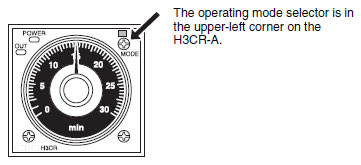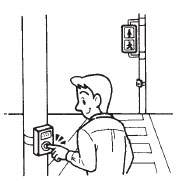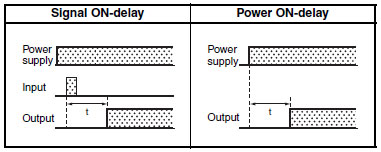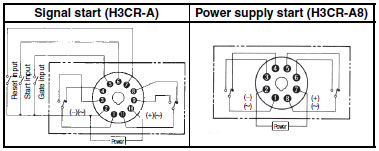Overview of Timers
A timer is a control device that outputs a signal at a preset time after an input signal is received.
Timer Mechanisms

Settings

1. Time setting knob
2. Time unit selector
3. Time range selector
4. Operating mode selector
Note: A variety of time ranges can be set with the H3CR-A using the time unit selector and time range selector.
Indicators
The pointers on the timer do not move along with time as the hands of a clock do. Time progression cannot be discerned. Therefore, two operation indicators are provided on the upper left of the timer to identify the timer status.
5. Run/Power Indicator (Green)
Run indicator: Indicates whether the time is being clocked or the time has been reached.
Power indicator: Indicates whether power is being supplied to the timer.
Fundamentally, the indicator will be lit when the power is being supplied and will flash when the time is being counted.
6. Output Indicator (Orange)
Used to see the status of the output. Lit when a signal is output.

The operating mode determines the output method to use when the set time has been reached. The following four basic operating modes are the most commonly used.



When you get in your car, the ceiling light turns ON when the door is opened. The light remains lit for several seconds after you get into the car and close the door.
The light remains lit to avoid the inconvenience of having to search for the car keys in the dark.

The ceiling light turns ON at the same time the door switch turns ON by opening the door. The light remains lit even when the door switch is turned OFF by closing the door. In other words, the ceiling light turns OFF after a set time delay. This type of operation, in which the output turns ON at the same time as the input and then the output turns OFF when the timer contacts switch after the set time has expired (with the set time being calculated from when the input turns OFF) is called "OFF-delay operation."
This name is used because there is a delay between when the input turns OFF and when the output turns OFF.

An operation in which an output repeatedly turns ON and OFF once an input is received (as shown in the time chart at the left) is called "flicker operation."
Application: Automatic Control of Fountains

The water is repeatedly released and stopped at intervals of two minutes.

An operation in which the input and output turn ON at the same time and the output turns OFF after a set time (as shown in the time chart at the left) is called "interval operation."
Applications: Amusement Park Rides

There are two starting methods for the operating modes.
Example: ON-delay Operation
Signal ON-delay operation:
The time clocking starts when the input section receives an input while voltage is being applied to the timer power supply section.
Power ON-delay operation:
The time clocking starts when voltage is applied to the timer power supply section.

1. Accuracy (See note.):
Operation will not be stable unless a brief period elapses after the power supply is turned ON to the timing section of the timer.
Power supply start: Operation is unstable because the time clocking starts at the same time that the power supply turns ON. Therefore, deviation will occur in the operation time immediately after starting the Timer.
Signal start: sStable time accuracy is ensured because voltage is applied to the timer before starting the Timer.
The accuracy of the signal start is generally considered better.
For some models, however, such as the H3CR, there is no change in accuracy.
Note: Accuracy is the correctness of the time
2. Terminal Arrangement
